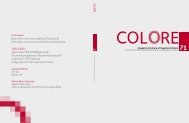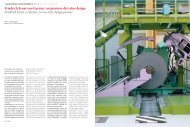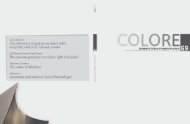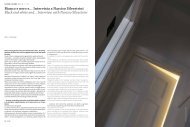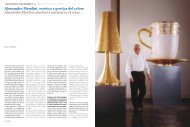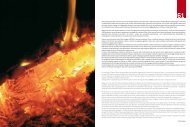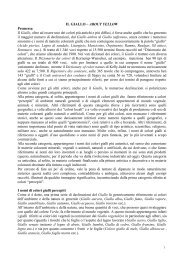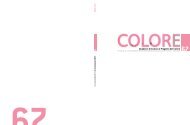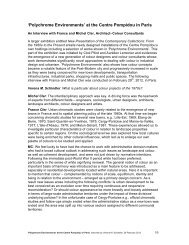Quaderni di Cultura e Progetto del Colore - Istituto Del Colore
Quaderni di Cultura e Progetto del Colore - Istituto Del Colore
Quaderni di Cultura e Progetto del Colore - Istituto Del Colore
You also want an ePaper? Increase the reach of your titles
YUMPU automatically turns print PDFs into web optimized ePapers that Google loves.
CULTURA / CULTURE [ 1 2 3 4 5 6 (7 + 8) 9 10 11 12 13 14 15 16 ] Colori <strong>del</strong>le città italiane / Colour of italian cities<br />
co”, “Stucco”, “Stucco or<strong>di</strong>nario bianchissimo”, “Stucco lucido”).<br />
Più raramente, a Torino, i colori imitano i materiali laterizi (mattone o<br />
terracotta) ed in particolare il primo, essendo questo impiegato per la<br />
realizzazione <strong>del</strong>la struttura grezza <strong>del</strong>le facciate, che andavano successivamente<br />
intonacate e tinteggiate, anche se, nel caso <strong>del</strong>la Via Po,<br />
realizzata in epoca barocca, ancora alla fine <strong>del</strong> ‘700 era rimasta ancora<br />
con i mattoni a vista, per cause economiche dovute alle guerre e alle<br />
pestilenze, e solo nell’800 verrà intonacata e colorata completamente.<br />
Molti dei gran<strong>di</strong> monumenti <strong>di</strong> Torino, come il Palazzo Carignano e l’Accademia<br />
<strong>del</strong>le Scienze <strong>del</strong> Guarini ecc., sono poi rimasti definitivamente<br />
senza intonaco, con i mattoni a vista, ma si tratta i<strong>di</strong> eccezioni (almeno<br />
fino alla metà <strong>del</strong>l’800).<br />
A volte, le imitazioni <strong>del</strong>l’intonaco o <strong>del</strong>la muratura rustica (“Tinta imitante<br />
il rustico”) hanno una funzione meramente mimetica provvisoria.<br />
L’imitazione dei colori dei materiali lignei attiene naturalmente ai serramenti<br />
(finestre, persiane o porte) o alle botteghe. I nomi <strong>di</strong> colori lignei<br />
più ricorrenti sono il “Bosco naturale” (bosco in piemontese significa legno,<br />
n.d.r.), “Noce”, “Nocciuolo”, “Noiset chiaro”, “Olivo”, “Olivâtre clair”,<br />
“Jaune clair bronzé”, “Verde d’olivo”, anche se in qualche caso alcuni<br />
<strong>di</strong> questi colori possono essere estesi alle murature, essendo i colori<br />
“Nocciuolo” e “Noiset chiaro” connotativi <strong>del</strong> colore naturale <strong>del</strong>la “calce<br />
<strong>di</strong> Superga”.<br />
L’imitazione dei colori naturali <strong>di</strong> materiali metallici si limita al “Bronzo”,<br />
per le ringhiere, e all’“Oro” per qualche particolare decorativo <strong>del</strong>le cancellate<br />
<strong>di</strong> pregio particolare, come ad esempio quella <strong>di</strong> fronte al Palazzo<br />
Reale, in Piazza Castello, restaurata <strong>di</strong> recente.<br />
Nel 1980, per cercare <strong>di</strong> dare un colore standard corretto ai materiali<br />
e<strong>di</strong>lizi , abbiamo cercato dei campioni <strong>di</strong> riferimento, sottoponendoli al<br />
sistema <strong>di</strong> ricettazione strumentale “Datacolor”, tenendo conto <strong>del</strong>le<br />
descrizioni presenti nei manuali <strong>di</strong> geologia applicata <strong>di</strong> Torino e <strong>del</strong><br />
Piemonte 10 .<br />
Genova e Regione Liguria<br />
Se a Torino, in epoca barocca, si impone il mo<strong>del</strong>lo <strong>del</strong> Theatrum Sabau<strong>di</strong>ae,<br />
caratterizzato da una colorazione prevalentemente imitativa<br />
<strong>di</strong> materiali lapidei, che rivestono le membrature decorative in muratura,<br />
la Genua Picta <strong>del</strong>lo stesso periodo non solo impiega colori imitativi<br />
<strong>di</strong> materiali lapidei e laterizi “locali”, ma riproduce artificialmente in<br />
trompe-l’oeil le stesse membrature sulle facciate generalmente piatte e<br />
gli stessi serramenti, introducendovi persino rappresentazioni <strong>di</strong> figure<br />
umane e animali, finte rovine ecc., come abbiamo potuto osservare a<br />
Sassello, una Genua Picta in miniatura, <strong>di</strong>ventato in questi ultimi anni<br />
un “Borgo-Laboratorio” <strong>di</strong> restauro <strong>del</strong>le facciate <strong>di</strong>pinte 11 .<br />
Seguendo lo stesso or<strong>di</strong>ne che abbiamo seguito per Torino e per il Piemonte,<br />
anche nel “Dizionario dei colori” <strong>del</strong>la Liguria emergono molti<br />
nomi <strong>di</strong> colori <strong>di</strong> pietre e marmi locali imitati con le tinte (i graniti sono<br />
più rari in quanto geograficamente e geologicamente più lontani ...).<br />
In Liguria, tra le pietre più imitate con il colore, domina quella <strong>di</strong> Finale,<br />
declinata nelle sue varie tonalità rosa e gialle (“<strong>Colore</strong> <strong>di</strong> pietra <strong>di</strong> Finale<br />
leggiero”, “Colorito a guisa <strong>di</strong> pietra <strong>di</strong> Finale”, “Figurante pietra <strong>di</strong> Finale”,<br />
“Giallognolo pallido che imiti la pietra <strong>di</strong> Finale”, “Pietra da taglio<br />
rossa <strong>di</strong> Finale”, “Tinta ad imitazione <strong>del</strong>la pietra <strong>di</strong> Portio”, “Finta pietra<br />
<strong>di</strong> colore giallo”, “Tinta che rassomigli alla pietra <strong>di</strong> Finale chiara”, “Tinta<br />
ated by the “Datacolor” instrumental system, taking into account the<br />
descriptions given in the applied geology manuals of Turin and Piedmont<br />
10 .<br />
Genoa and Liguria Region<br />
If in Turin, during the Baroque Period, the mo<strong>del</strong> of Theatrum Sabau<strong>di</strong>ae<br />
stands out, characterized by a colouring mainly imitating the stone<br />
materials, that cover the decorative brickwork structures, Genua Picta,<br />
as Genoa was called during the same period, not only uses colours<br />
imitating “local” stone and brick materials, but, in a trompe-l’oeil effect,<br />
artificially reproduces the same structures on generally flat facades<br />
as well as on the frames, even introducing representations of human<br />
and animal figures, fake ruins, etc., as we could notice in Sassello, a<br />
sort of miniature Genua Picta, that in the last few years has become a<br />
“Laboratory-Town” for the restoration of painted facades 11 .<br />
Following the same order that we have used for Turin and Piedmont, in<br />
the “Dictionary of colours” of Liguria many colour names taken from<br />
local stones and marbles do stand out (granites are rarer because geographically<br />
and geologically far away…).<br />
In Liguria, among the stones mostly imitated by colours , the one from<br />
Finale stands out, varied in its many pink and yellow hues (“Light Finale<br />
stone colour”, “Colour imitating Finale stone”, “Mocking Finale<br />
stone”, “Pale yellowish imitating Finale stone”, “Red cut Finale stone”,<br />
“Paint imitating Portio stone”, “Yellow coloured fake stone”, “Paint similar<br />
to light Finale stone”, “Paint of light Finale stone” etc.).<br />
In Liguria another stone obviously imitated by colour (besides being<br />
employed as a material, in the richest buil<strong>di</strong>ngs) is generally ”Slate”<br />
and ” Lavagna quarries slate”, “Lavagna”, “Lavagna stone”.<br />
Sometimes, as it happens in Piedmont, the chromatic reference to the<br />
stone is generic (“Stone”, “Fake stone”, “Yellow coloured fake stone”,<br />
“Grey coloured stone” , “Dark stone colour”, “Black stone”, “Dark stonelike<br />
colouring”).<br />
To a closer look, by the way even these colours sometimes in<strong>di</strong>cate<br />
specific stones. The “Yellow coloured fake stone”, for instance, for sure<br />
identifies Finale stone and “Black stone” probably in<strong>di</strong>cates slate, because<br />
it is commonly used for plastering gates made with less durable<br />
materials (and therefore less prestigious) such as Sassello or Dego<br />
stones, characterized by the typical greenish-grey colour.<br />
Even regar<strong>di</strong>ng marble, the in<strong>di</strong>cation is often generic (“Marble”, “Marble<br />
colour”, “Light marble colour”, “Imitation of marble”, “Fake marble”,<br />
“Representing marble”, “Representing a light marble”, “In a marble<br />
mocking way”, “Coloured marble”, “Black marble”), leaving the painter<br />
free of interpreting it as he prefers.<br />
Sometimes, the marble colour is mentioned instead referring to the extraction<br />
site or to its own colour (“Bar<strong>di</strong>glio marble” or simply “Bar<strong>di</strong>glio,<br />
pale blue-grey coloured “, varied in “Light Bar<strong>di</strong>glio ” and in “Flowering<br />
Bar<strong>di</strong>glio”, “Spain Brogatello”, “Verona fake yellow marble” etc.).<br />
A particularly imitated marble in Liguria, besides being used as it is,<br />
is the white marble of the nearby Carrara (“Fake marble white”, “Marble-mocking<br />
white”, “White marble colour”, “White marble-like colour”,<br />
“Representing statuesque marble”, “Fake statuesque marble”, “Made<br />
by pale white marble”, “White marble”, “ Carrara quarries white marble”,<br />
“Carrara white marble”, “Veined white marble”, “Veined or<strong>di</strong>nary<br />
<strong>di</strong> pietra <strong>di</strong> Finale chiara” ecc.).<br />
Un’altra pietra ovviamente imitata col colore in Liguria (oltre ad essere<br />
impiegata al naturale, negli e<strong>di</strong>fici più ricchi) è l’”Ardesia” in generale e<br />
l’”Ardesia <strong>del</strong>le cave <strong>di</strong> Lavagna”, “Lavagna”, “Pietra <strong>di</strong> Lavagna”.<br />
A volte, come avviene in Piemonte, il riferimento cromatico alla pietra<br />
è generico (“Pietra”, “Finta pietra”, “Finta pietra <strong>di</strong> colore giallo”, “Pietra<br />
colore biggio” , “<strong>Colore</strong> <strong>di</strong> pietra scura”, “Pietra nera”, “Coloramento scuro<br />
imitante la pietra”).<br />
A ben vedere, tuttavia anche questi colori a volte connotano pietre precise.<br />
La “Finta pietra <strong>di</strong> colore giallo”, ad esempio, identifica sicuramente<br />
la pietra <strong>di</strong> Finale e la “Pietra nera” probabilmente connota l’ardesia,<br />
visto che essa viene impiegata correntemente per la “scialbatura” <strong>di</strong><br />
portali eseguiti con materiali meno duraturi (e dunque meno nobili)<br />
come la pietra <strong>di</strong> Sassello o <strong>di</strong> Dego, dal caratteristico colore grigioverdastro.<br />
Anche per il marmo, molte volte l’in<strong>di</strong>cazione è generica (“Marmo”, “Color<br />
<strong>di</strong> marmo”, “Color <strong>di</strong> marmo chiaro”, “Ad imitazione <strong>del</strong> marmo”, “Finto<br />
marmo”, “Figurante <strong>di</strong> marmo”, “Color <strong>di</strong> marmo chiaro”, “In modo <strong>di</strong><br />
rappresentare un marmo chiaro”, “In maniera che finga marmo”, “Marmo<br />
colorato”, “Marmo nero”), lasciando al pittore <strong>di</strong> interpretarlo come<br />
meglio crede.<br />
Altre volte, il colore <strong>del</strong> marmo è invece in<strong>di</strong>cato in modo preciso con il<br />
riferimento al luogo <strong>di</strong> estrazione o al suo stesso colore (“Marmo Bar<strong>di</strong>glio”<br />
o semplicemente “Bar<strong>di</strong>glio, dal colore grigio-celeste “, declinato<br />
in “Bar<strong>di</strong>glio chiaro” e in “Bar<strong>di</strong>glio fiorito”, “Brogatello <strong>di</strong> Spagna”, “Finto<br />
marmo giallo <strong>di</strong> Verona” ecc.).<br />
Un marmo particolarmente imitato, oltre che impiegato al naturale, in<br />
Liguria, è il marmo bianco <strong>del</strong>la vicina Carrara (“Bianco finto marmo”,<br />
“Bianco in maniera che finga marmo”, “<strong>Colore</strong> <strong>di</strong> marmo bianco”, “Colorito<br />
a modo <strong>di</strong> marmo bianco”, “Figurante marmo statuario”, “Finto<br />
marmo statuario”, “Figuri eseguito con marmo bianco chiaro”, “Marmo<br />
bianco”, “Marmo bianco <strong>del</strong>le cave <strong>di</strong> Carrara”, “Marmo bianco <strong>di</strong> Carrara”,<br />
“Marmo bianco venato”, “Marmo bianco venato or<strong>di</strong>nario”).<br />
Il granito, come si è detto, è più raramente imitato in Liguria, anche se<br />
non manca qualche esempio (“Pietra artificiale che imiti possibilmente<br />
il granito”, “Pietra artificiale imitante il granito”).<br />
Tra i materiali laterizi, il mattone è il più imitato (“<strong>Colore</strong> <strong>del</strong> mattone”,<br />
“Laterizio”, “Laterizio a paramento visto”, “Paramento visto”, “Paramento<br />
naturale”, “Rosso mattone”), anche se le facciate <strong>di</strong>pinte in trompel’oeil<br />
esibiscono sovente particolari decorativi in terracotta, materiale<br />
plasmabile nelle fogge più complesse e a volte improbabili in cui la bravura<br />
dei pittori si può meglio esibire.<br />
Tra i materiali lignei citati nei documenti d’archivio, compare il “Legno” e<br />
“Color <strong>del</strong> legno” e, tra i metalli, i soliti “Bronzo” e Oro”.<br />
Un’imitazione o quanto meno un riferimento particolare ai materiali<br />
e<strong>di</strong>lizi (che in Piemonte compare meno frequentemente e <strong>di</strong> solito con<br />
funzioni mimetiche) è rappresentato dal colore <strong>del</strong>le sabbie degli intonaci<br />
lasciati a vista (“Tinta verdognola simile al colore <strong>del</strong>l’arena <strong>di</strong> Sestri”,<br />
“<strong>Colore</strong> giallognolo <strong>del</strong>l’”arenino <strong>di</strong> Viareggio”, “<strong>Colore</strong> <strong>del</strong>l’ arenino<br />
<strong>di</strong> Spezia”, “<strong>Colore</strong> stesso <strong>del</strong>l’intonaco”, “<strong>Colore</strong> naturale e finito con<br />
minuta arena”, “Intonaco a semplice rinzaffo”, “Rinzaffo con malta <strong>di</strong><br />
calce e arena” ecc.).<br />
Come in Piemonte, anche in Liguria è ugualmente molto imitato il colore<br />
white marble”).<br />
Granite, as has been said before, is rarely imitated in Liguria, even if<br />
there are some examples (“Artificial stone possibly imitating granite”,<br />
“Artificial stone imitating granite”).<br />
Among brick materials, brick itself is the most imitated (“Brick colour”,<br />
“Brickwork”, “Exposed battlement brickwork”, “Exposed battlement”,<br />
“Natural battlement”, “Brick red”), even if the painted facades, trompel’oeil-style,<br />
often show terracotta decorative details, a material pliable<br />
into very complex and sometimes unlikely shapes where the painters<br />
skill may better show itself.<br />
Among the wooden materials cited in the archives documents, there<br />
is “Wood” and “Wood colour” and, among metals, the usual “Bronze”<br />
and “Gold”.<br />
An imitation or at least a specific reference to buil<strong>di</strong>ng materials (that<br />
in Piedmont appears less frequently and usually having mimetic functions)<br />
is the colour of the sands of exposed plaster (“Greenish paint<br />
similar to Sestri sand colour”, “Yellowish colour of Viareggio sand”,<br />
“Spezia sand colour”, “The very plaster colour”, “Natural colour and finished<br />
with fine sand”, “Plaster in a single layer”, “Lime and sand layering”<br />
etc.).<br />
As in Piedmont, also in Liguria the white stucco colour is equally often<br />
imitated (“Stucco colour white”, ”Stucco”, “Stucco colour paint”, “Stucco<br />
paint”, “Light stucco paint”, “White stucco”, ”Stucco” etc.).<br />
As in Piedmont, then, we have the colours <strong>di</strong>rectly provided by limes<br />
(“White”, “Milk of lime”, “Rich milk of lime properly <strong>di</strong>luted”, “Plaster”,<br />
“Milk of lime whitewash”, ”Whitening”). Sometimes, the white from<br />
“light lime” is linked to the specific name of the locally used lime (from<br />
Cogoleto, from Sestri Ponente or from Spotorno). Other times, the yellowish<br />
colour is the one typical of wet lime from Casale, that the railroad<br />
development little by little contributed in sprea<strong>di</strong>ng it all over Italy.<br />
Concerning the other strong limes cited in documents, such as those<br />
from Borghetto or from Oneglia, there is no way to know what the actual<br />
colour was.<br />
Finally, as in Piedmont, , also in Liguria, sometimes colours are defined<br />
by the pigments by which lime paints or oil paints are composed<br />
(“Shadow earth”, “Yellow earth”, “More intense sienna yellow”, “Black”,<br />
“English red” etc.).<br />
Siena<br />
Even in Siena the “mimetic” colouring criterion seems to be confirmed,<br />
as seen in Turin and Piedmont and in Genoa and Liguria, even if in this<br />
case others are the colours that dominate the image of the city, because<br />
of the <strong>di</strong>fferent “applied geology” of the place and, not by chance, the<br />
best colour experts of Siena are actually the specialists of local stone<br />
and brick materials 9 .<br />
With regard to colours that imitate local buil<strong>di</strong>ng materials we find, as<br />
usual, the limes, in their <strong>di</strong>fferent variations (“Light lime”, “Yellow spotted<br />
light lime”, “Natural light lime”, “Dark lime”, “Lime colour”, “Light<br />
lime colour”, “Natural light lime colour”, “Natural lime imitation”, “Aged<br />
light lime colour”, “Aged light lime colour”, “Natural light lime dye”).<br />
In Siena, in ad<strong>di</strong>tion to lime derived names, obviously there are also the<br />
names of pigments and in particular the “colouring earths” of which<br />
Tuscany and Siena are rich (“Yellow earth” and “Shadow burnt earth”),<br />
38 COLORE<br />
COLORE 39



